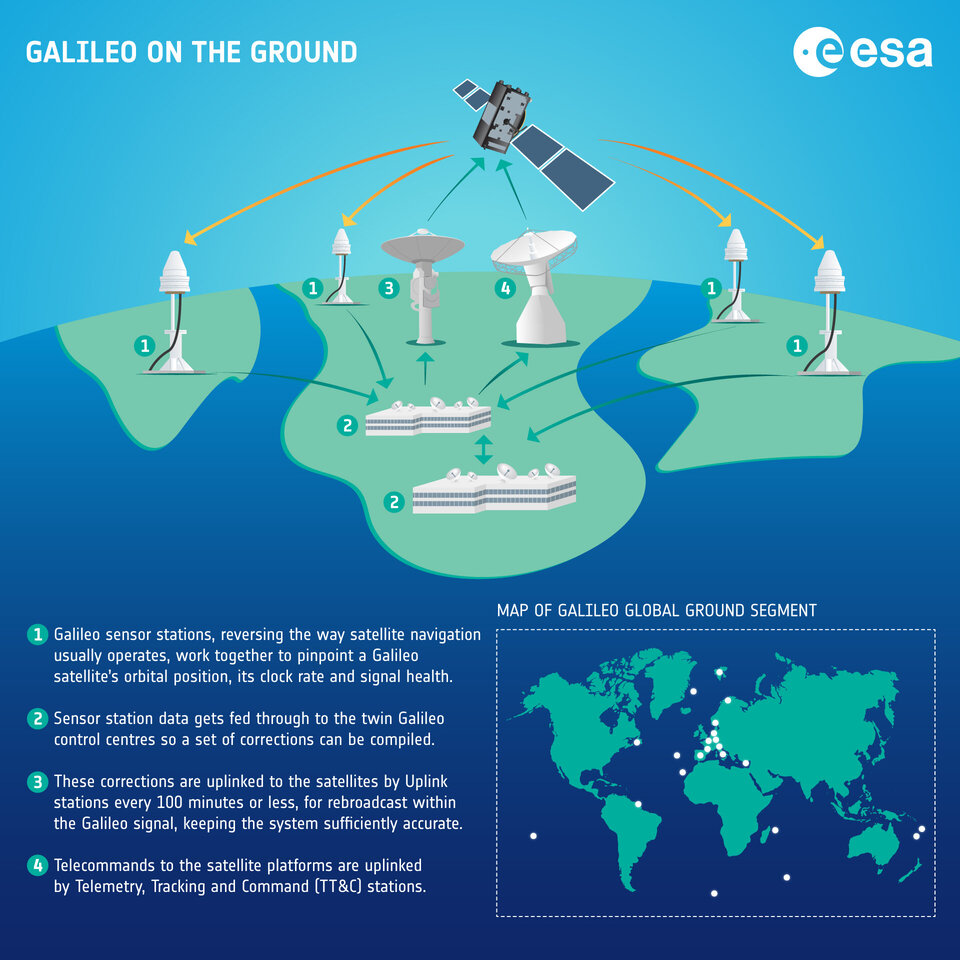First ever ESA Academy Navigation Training Course!
For the first time ever, ESA Academy is opening a call for university students to apply for the pilot edition of the Navigation Training Course, to be held from 26 to 30 June 2023 at ESA Academy’s Training and Learning Facility in ESEC-Galaxia, Belgium. This Training Course has been developed by ESA Education and ESA’s Directorate of Navigation. Would you like to know more about the future of satellite navigation? Apply for our course today!

The Global Navigation Satellite System (GNSS) is of major importance not only for ESA, who has pioneered its introduction in Europe since the 90s, but for all European citizens and industry in all areas since it plays an essential role in our economy and daily lives. Using indoor or outdoor navigation, applications related to GNSS mainly focus on determining the global reference system position at any time around the globe in a fast, simple, and cost-effective way. Developing GNSS is fundamental since it has a sensitive and strategic nature. Its development is subjected to technological changes, political decisions, and market expectations. Satellite navigation has also evolved into the largest downstream market of space applications.
Galileo is currently the world’s most precise satellite navigation system, serving four billion users around the globe. It is a flagship programme of the EU Space Programme, managed and funded by the European Union, and since its inception, ESA has led the design and development of the space and ground systems, as well as the launch procurements. EUSPA (the EU Agency for the Space Programme) acts as the service provider of Galileo, overseeing the market and application needs and closing the loop with users.
ESA’s Directorate of Navigation oversees the system design and development of Galileo and EGNOS, Europe’s two satellite navigation systems, as well as its future development via the EU’s R&D Horizon Europe programme. In addition, ESA’s Directorate of Navigation is working to reinforce the future of satellite navigation via its programmes FutureNAV (GENESIS and LEO-PNT) and NAVISP (Navigation Innovation and Support programme).
Training Course Description

ESA intends to provide university students with an overview and introduction to Satellite Navigation with a specific focus on Galileo. Designed by ESA experts that developed the Galileo Space and Ground Segment, this training course will provide students with fundamental knowledge of Galileo’s architecture, tools, services and functionalities.
The training course will include lectures and hands-on practical group exercises together with a tour of key Galileo in-orbit test facilities in ESEC which provide an essential part of the current Galileo Ground Segment.
Upon completion of the Training Course, students will be evaluated through an online questionnaire and will receive a certificate of participation and course transcript, allowing them to request ECTS credit(s) from their respective universities.
The week before the workshop, the selected students will follow a 2h Capella and GNU Octave tutorial to allow them to become familiar with the tools they will use.
Preliminary schedule
| Day 1 | Basics of GNNS |
| Day 2 |
Introduction to Galileo and Services Galileo Architecture Galileo System Performance Galileo Constellation Design Group exercise |
| Day 3 |
Galileo Space Segment Galileo System Performance Tools Introduction to Galileo System Modelling Group exercise |
| Day 4 |
Galileo Support to Safely of Life Introduction to Galileo Signals, Galileo Signal Processing and calculate position Group exercise |
| Day 5 |
Galileo Ground Segment Galileo Satellite In-Orbit Testing (IOT) Visit of Galileo in-orbit test facilities in ESEC Galileo Search and Rescue, Beacon Command Service, Emergency Warning System |
Who can apply?
Applications are open to students enrolled in university who fulfil the following criteria:
- aged minimum 18 years old; ESA Academy and relevant partners will only appraise applications from students who have no or limited professional experience in relevant engineering or space-related topics;
- be a citizen of an ESA Member State, Canada, Latvia, Lithuania, Malta, Slovakia or Slovenia;
- be enrolled as a Master (BSc completed) or Ph.D. student in a university (not graduating before the training course);
- be studying an engineering or scientific subject with basic knowledge on navigation.
- Knowledge of GNU Octave would be an asset but is not required
Selected students will be required to attend the entire 5-day training course at ESEC. They will be sponsored by ESA to cover accommodation and meals, as well as up to 300 Euros for travelling to Belgium.
How to apply?
- Fill in the application form;
- Upload a motivation letter (PDF, maximum 1 page, no images);
- Upload a CV (PDF, Europass format, maximum 2 pages, no images);
- Upload a formal recommendation letter (PDF, maximum 1 page, including signature, no images) from a university professor or academic supervisor of current university (if it is not possible to receive the recommendation letter from your referee, please ask them to send a recommendation email to tlp@esa.int before the application deadline);
- Upload a copy of your academic records (PDF).
All answers and documents should be in English (except academic records if not available).
The deadline for applications is Monday 8 May 2023 at 23:59 CEST.
For more information, please contact tlp@esa.int.


